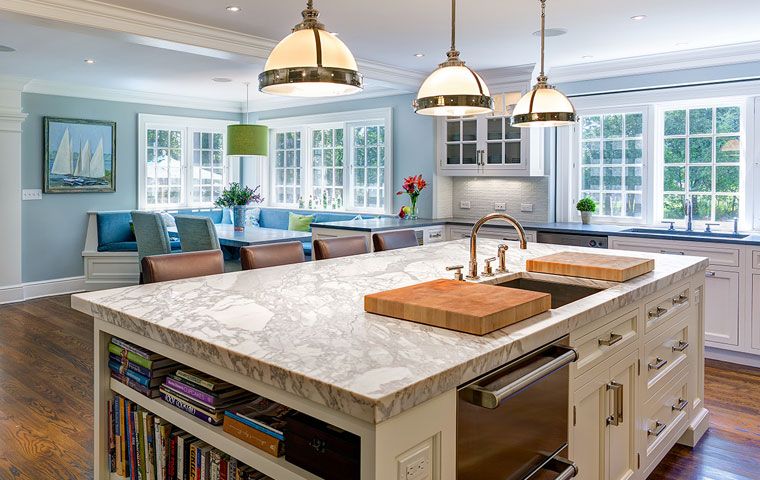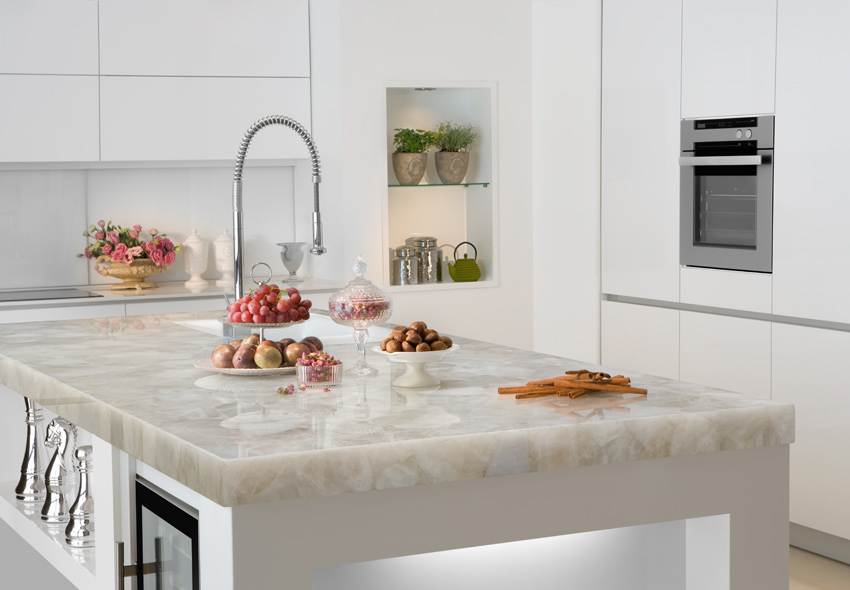Cutting engineered stone is a high-stakes project—slabs are costly, heavy, and packed with crystalline silica. Whether you’re a determined DIY-er making a single sink cut-out or a fabrication shop automating production with 5-axis sawjets, this guide walks through every step so you can cut quartz safely, accurately, and within budget.
Essential Requirements for Cutting Quartz
- Diamond tooling – Continuous-rim diamond blades (7–10 in. for hand saws, 14–18 in. for bridge saws) rated for stone.
- Water feed or vacuum shroud – Keeps the blade cool and traps silica dust.
- Rigid straightedge and clamps – Prevents the saw from wandering on long rips.
- Personal protective equipment – N95 or half-mask respirator with P100 filters, safety glasses, hearing protection, steel-toe footwear.
- Silica dust controls – OSHA’s limit is 50 µg/m³ over eight hours. Rely on wet cutting, HEPA vacuums, and local exhaust ventilation.
- Stable work surface – A sacrificial foam or plywood deck on sturdy sawhorses supports the slab and dampens vibration.
- Two or more helpers – A 3 × 8 ft quartz slab can weigh 250 lb; use suction cups or a slab cart when moving it.
Safety & Silica Dust Control
- Run water on every cut or attach a vacuum shroud.
- Ventilate the space—negative-pressure fans help indoors.
- Clean only with a HEPA vacuum; never dry-sweep quartz dust.
- Provide respirators, medical checks, and safety training for anyone who cuts quartz regularly.
How to Cut Quartz with a Handheld Saw
- Measure twice, template once. Mark the underside with painter’s tape and a grease pencil. Leave 1 ½ in. of overhang where needed.
- Score a shallow kerf. Start the saw outside the line and cut ⅛ in. deep to limit chipping.
- Turn on water or dust shroud. Engage dust control before plunging to full depth.
- Feed steadily. Let the diamond blade do the work—forcing it overheats the resin binder.
- Pause at corners. Drill a ⅜ in. relief hole at each sink corner to avoid cracks, then connect the cuts.
- Dress the edge. Smooth with a variable-speed grinder and a 200-grit resin pad, working up to 400 grit for a factory-like finish.
Finishing & Edge Polishing
After cutting, polish the edge with sequential diamond pads (200 → 400 → 800 grit) at about 2 500 rpm, using a light water spray. Dry the edge and inspect for swirl marks; repeat with finer pads if needed. A final buff with a felt wheel restores full gloss.
Mitering Quartz for Tight Joints
Mitering at 45 degrees lets you “wrap” vein patterns over islands and waterfall ends.
- Set the blade to 45 °. Lock the bevel gauge on a track or bridge saw.
- Use sacrificial backing. Place scrap quartz behind the cut to protect the trailing edge.
- Cut both parts face-up. When folded, the factory surfaces meet for an invisible joint.
- Epoxy and clamp. Apply color-matched epoxy, align the veins, and clamp until cured.
Quartz Cutting Solutions with Park Industries
Professional shops looking for speed, accuracy, and repeatable quality often rely on Park Industries® machinery. Below is a snapshot of the lineup and what each model offers.
JAVELIN™ CNC SawJet
- 27 hp arbor motor (0–4 500 rpm).
- Dual cutting heads: diamond blade plus abrasive waterjet.
- Automatic 0–58 ° mitering with MiterJet.
- Jumbo-capable table (144 × 88 in.).
SABERjet™ XP CNC SawJet
- “Load-and-Go” barcode scanning for hands-off operation.
- 27 hp blade paired with a 60 000 psi waterjet.
- Touchscreen control and rapid programming shortcuts.
VOYAGER™ XP CNC Saw
- True 5-axis saw for contour cutting and incremental routing.
- Handles 14–24 in. blades and cuts up to 141 × 141 in.
- Automatic 0–47 ° mitering and TightCut™ nesting to save material.
YUKON® II Bridge Saw
- Semi-automatic bridge saw for shops wanting digital accuracy without full CNC pricing.
- Powered bridge miters up to 47 °.
- Rugged construction and repeatable straight-line performance.
Why Choose Park Industries?
- Proven uptime – Cast-iron bridges and helical rack-and-pinion drives withstand continuous production.
- Intuitive software – EZ-flow screens shorten the learning curve.
- U.S.-based support – 24/7 phone assistance and on-site technicians reduce downtime.
- Integrated workflow – Templating, nesting, cutting, and edge-polishing modules communicate seamlessly.
- ROI transparency – Built-in payback calculators compare machine cycle time to manual labor.
Additional Techniques and Best Practices
Digital Templating & Layout
Laser templating captures cabinet geometry to within ±0.5 mm. Import that file into CAD/CAM software, nest parts on a high-resolution slab photo, and rotate pieces to align vein direction before making a single cut.
Waterjet vs. Blade vs. SawJet
| Method | Strength | Limitation |
| Diamond blade | Fast straight cuts, low operating cost | Inner radius > 3 in., risk of chips |
| Pure waterjet | Intricate curves, sink cut-outs, zero chips | Slow on long straight lines, higher consumable cost |
| SawJet combo | Blade handles rips; jet handles curves in one setup | Higher upfront machine cost |
Common Mistakes to Avoid
- Cutting dry—violates OSHA regulations and can void tool warranties.
- Rushing a plunge cut—fractures the resin binder at the entry point.
- Skipping backer boards on miter cuts—chips the exit edge.
- Forgetting relief holes—tight inside corners become stress risers.
Conclusion
From trimming a single vanity top to producing dozens of kitchens per day on a 5-axis sawjet, success in cutting quartz comes down to precision, dust control, and the right equipment. Hand tools give homeowners a pathway to small modifications, while Park Industries’ machines deliver speed and repeatability for high-volume shops. Follow OSHA silica guidelines, rely on diamond tooling with plenty of water, and plan every miter before powering up the blade—your lungs, your wallet, and your clients will all thank you.


